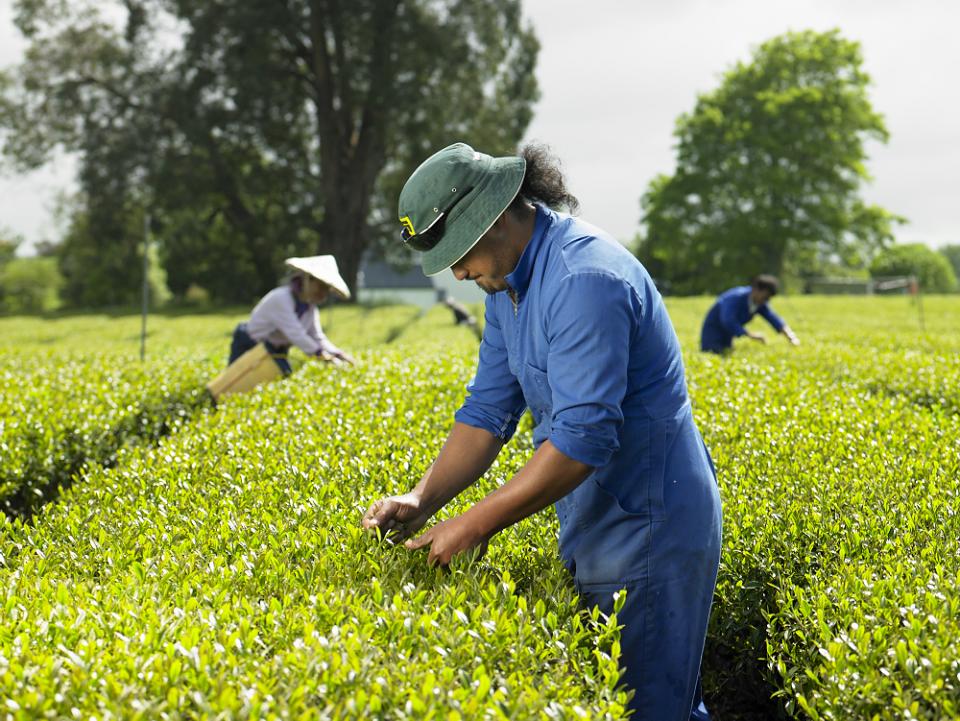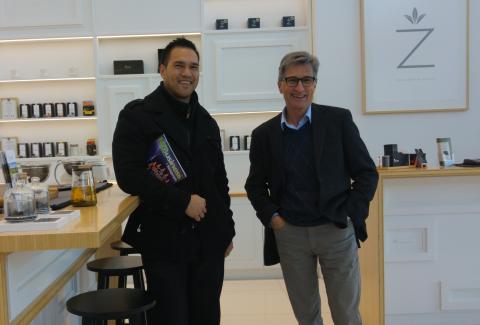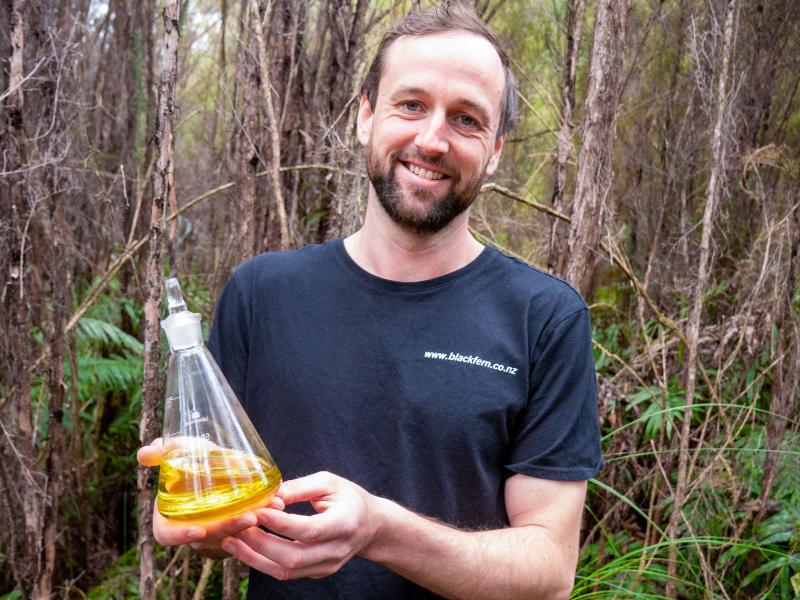With its tea brand already established in the domestic market, Waikato-based Zealong is now enjoying success as New Zealand’s very own premium tea exporter. Demand from discerning tea drinkers is growing around the globe.
You might think you would have to travel to China, India or Sri Lanka to visit a genuine tea plantation using traditional harvesting and production methods. But travel just a short distance out of Hamilton along Gordonton Road, and on your left you can discover the world-class, unique, and pleasantly surprising, Zealong tea estate.
Everything about this tea estate commands your senses – from the breathtakingly beautiful landscape with neatly trimmed and uniform rows of tea plants, to the delightful tea house (the original farm homestead) and The Vista – an imposing, white, purpose-built facility housing Zealong’s boutique retail shop (a blueprint for its overseas shops), function spaces and factory.
On a gloriously fine day, Zealong truly is a ‘slice of heaven’. It’s no wonder locals and tourists are flocking to discover the Zealong tea experience, with guided tours that unlock a whole new world of tea. I’m told bookings are essential.
The story of how Zealong got started has been well documented. Tzu Chen was inspired by flowering camellias in the region and, together with son Vincent, decided to import tea seedlings from Taiwan in 1996 and ultimately produce the only true New Zealand tea; 100 percent organic, traceable and produced without compromise.
To borrow from that well-used saying: seeing, and tasting, is believing.
And now the company is on a mission to take New Zealand’s own premium tea to a discerning world market. Already 70 percent of production is consumed offshore.
Sen Kong, Zealong’s marketing manager (pictured below left), grew up in the Waikato, graduated from Waikato University, and is the export mission’s enthusiastic leader. He reports that the past year has seen some major wins for the company’s export strategy. It has a flagship store in Beijing (yes, New Zealand is now selling tea to China!); a supply deal with Harrods in London; and it’s VIP-infused list of aficionados includes the Duchess of Cornwall, Japan’s First Lady and the Chinese Premier.
Once a tea drinker has heard the story and sampled Zealong’s special blends, it’s always a thumbs up.
Sen says local domestic sales have also been vital to the company’s export strategy – because social media is a powerful platform for sharing positive reviews with a global audience.
The chain of Mojo cafes is one example of a local partnership that is exposing the brand story to similar business model types internationally, he says.
“Once people start talking about our tea, opportunities grow.”
To date China and Europe (and more specifically Germany) have been the company’s biggest gains in offshore markets. Although China is saturated with premium tea, as you would expect, Sen says New Zealand’s ‘clean green’ story resonates with discerning consumers.
Nevertheless, securing such an important tea stronghold has not been easy, and, along with Germany, is a work in progress, with a distributor/partner arrangement helping to open doors.
There are also plans underway to capture markets in the UK, Czech Republic, The Netherlands, Switzerland and Japan. However, with a small team at Zealong, other countries – even Australia – will have to wait. “It’s easier in certain markets to just highlight your [brand story] and wait for those ‘champions’ to come looking for you,” explains Sen.
He says it’s common for buyers to have their first experience of Zealong tea at the estate’s popular tea house. And visitors to the estate become their best ambassadors here and offshore – “which is actually the best form of marketing”.
Getting the brand to where it is today has been a process involving time and education, Sen explains, as well as trial and error (even before it was first released to market in 2010).
Having the right people sample the tea has been paramount – President Xi Jinping, Premier Li Keqiang and other senior Chinese officials try Zealong tea has done much to position the product in China.
Brand exposure is very important when targeting specific markets, Sen says, which is why Zealong enters, and succeeds in, so many international awards.
As for distribution, he explains that the wholesale/auction method is typically used by tea brands – however, the issue with this is losing control of your product. “By the time it reaches the customer, the product can be up to a year old. Quality and freshness can also be compromised through poor storage.
That’s why Zealong’s priority is total control over the supply chain, he says. “So the customer gets the product exactly as we intended. That’s why every Zealong product is traceable from the farm to the cup.”
In China the company works with partners to establish its ‘bricks and mortar’ retail presence and manage direct sales – to ensure the product is accurately positioned in the premium sector.
In Germany, where the competition is extremely tough, TeeGschwendner, the world’s largest specialty tea retailer, stocks Zealong tea in all of its 123 German stores.
“They prefer minimal, sustainable packaging, and collaborative branding – and our product is shipped directly from their central warehouse,” says Sen.
He says the ‘mass volume’ e-commerce commodity market is not a focus for the brand at the moment, as they prefer to accentuate the sensory experience of drinking their tea – “exploring the visual and aromatic cues and the taste sensations”. However, his marketing team is constantly active on social media channels building brand awareness and loyalty, as well as sales, in markets where there is no exclusive contract in place.
Breaking barriers
New Zealand is known worldwide for products such as dairy, meat, wool, wine and kiwifruit, but understandably not for its tea – not yet anyway. It has been necessary to break down some perceptions and open peoples’ minds when introducing the Zealong brand, says Sen.
“But it is a lot easier now than it was in the beginning,” he says. “It’s been a case of getting our product in front of as many of the right people as possible. Because once people have tasted our product, they want to buy it.
“It looks elegant in its packaging sitting on the shelf, but it won’t move until people understand more about it.”
Having sampled several of Zealong’s blends I can understand his point exactly.
Tourism is a large part of Zealong’s marketing strategy, adds Sen. “We export our tea to the world, but at the same time we want to bring people of the world to our tea.”
Again, social media has a role to play, with people sharing images and experiences on Facebook, Instagram and WeChat. While large tour buses are discouraged, the number of independent travellers and guided tours visiting the estate has increased each year as word of mouth spreads awareness.
“Our partners in China were originally sourced through word of mouth from tea house visitors,” says Sen. “People enjoy their experience here; they like our products and they want to take them home with them.”
Big export future
People traditionally read tea leaves to predict the future – but Sen Kong would rather rely on their well-considered export strategy to predict where the brand will be in, say, another five years’ time.
He believes the Zealong brand will have a significant presence across China and Asia, both in bricks and mortar stores and e-commerce. Right now they’re seeking distributor partners in certain regions with a view to replicating their brand presence, and they’re busy building Zealong’s brand reputation and credibility.
“So no matter where people go, if they see the Zealong brand they instantly know it’s New Zealand-grown tea. That’s huge for us.”
Having the FernMark helps. Zealong was one of the first FernMark licensees – which means consumers can have the satisfaction of knowing they’re buying a fully authenticated product.
Europe and Japan are two other markets expected to grow significantly as brand recognition and credibility beds in.
The original vision that Vincent Chen and his father had for traditionally grown and harvested New Zealand tea all those years ago has come to fruition. Their passion and pride permeates down through the whole team at Zealong, and Sen is excited not just about the market potential for the Zealong brand, but the potential for the tea plant itself in terms of nutritional benefits.
As marketing jobs go, this one ranks right up there – selling New Zealand and its very own home-grown tea to the world and meeting some high-profile people in the process.
The job’s not done yet – there are markets to capture. But he’s seen the respect, appreciation and enthusiasm from people overseas for the Zealong story, and he knows how dedicated his team is to producing a premium product
“We’re putting New Zealand on the world map; we’re making a difference. And that’s what’s so great about Zealong – it’s all about opportunities.”
Written by Glenn Baker, editor of NZBusiness and ExporterToday. This story first appeared in the August 2018 edition of NZBusiness.






